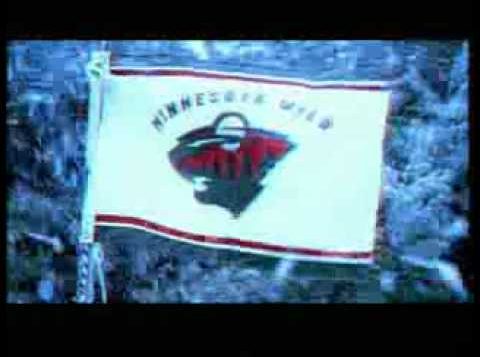This Day in Hockey History – June 25, 1997 – St. Paul in the Fab Four
You betcha, on June 25, 1997, the NHL made official the most recent multi-team NHL expansion. To reach the goal of 30 teams by the turn of the millennium, the NHL laid plans to gradually add four franchises. The Nashville Predators would begin play during the 1998-99 season, followed by the Atlanta Thrashers the next season. The 2000-01 season would introduce the Columbus Blue Jackets and the Minnesota Wild. Having posted about Atlanta and Columbus already, this post focuses on St. Paul, Minnesota.
The new franchise announcement came about 30 years after the Minnesota North Stars joined the NHL in the great expansion of 1967. They had played at the Metropolitan Sports Center (Met Center) in Bloomington for 26 seasons until 1993, when they relocated to become the Dallas Stars.
Minnesotans truly felt the loss of their professional hockey team. “I think we missed the NHL more than we ever thought we’d miss it,” said investor Bob Naegele, Jr. “The enthusiasm for NHL hockey has been pent up and is starting to emerge and manifest now into an unbelievable groundswell.” The mayor of St. Paul, Norm Coleman, campaigned to bring in a franchise, whether by relocation or creation. To their disappointment, Minnesota failed to secure the Winnipeg Jets (who moved to Phoenix in 1996) or the Hartford Whalers (who moved to Carolina in 1997).
Finally, Naegele headed the Minnesota Hockey Ventures Group and applied for an expansion franchise. The third time had proved the charm. At a six-hour meeting at New York City, NHL owners unanimously voted in favor of a new Minnesotan franchise. “We’re going back to hockey country because I feel we belong in Minnesota,” pronounced Commissioner Gary Bettman. “It hasn’t sunk in that I’m a sports owner,” commented Naegele. “I feel more like the ambassador from Minnesota.”
Soon after the June 25 meeting, 500 to 600 Minnesotans celebrated at Rice Park in St. Paul with “confetti, live music, free hot dogs and pizza, the St. Paul Bouncing Team, Camp Snoopy characters, [and] Goldy Gopher.” Naegele declared, “On behalf of more than 4 million fans in Minnesota, we’re very proud to bring hockey back to a place of its real heritage in the United States. This gives an opportunity for 50,000 boys and girls playing hockey at the youth, high school and college level to see the best hockey players in the world. And they deserve it because of our rich hockey heritage.” Mayor Coleman told the crowd, “It’s a great day for St. Paul, it’s a great day for Minnesota. Three years ago, people said it would take a miracle to bring the NHL back. My friends, a miracle has happened.”
The miracle had two caveats. Each of the four franchises had to give the NHL a $10 million non-refundable downpayment (on the $80 million entrance fee) by end of the week and sell 12,000 season tickets and 75% of their suites within four months of their first game. Despite having three years before their first game, Minnesota opened ticket sales the very next day.
The team also needed an arena. They had demolished the Met Center back in 1993, and, in June 1998, they tore down the inadequate St. Paul Civic Center to make way for a replacement. The state approved a $65 million loan to the city, which added its own $65 million in sales tax revenue bonds. The NHL franchise formed a 26-year partnership with the Minnesota Amateur Sports Commission (MASC). They would play in the brand-new Xcel Energy Center in St. Paul.
For the team name, they announced six finalists on November 20, 1997. The team could have been called Blue Ox, Freeze, Northern Lights, Voyageurs, White Bears, or Wild. On January 22, 1998, at Aldrich Arena at Maplewood, Steppenwolf’s “Born to be Wild” blared as the team was christened the Minnesota Wild.
Having built up their team through the Expansion Draft on June 23, 2000 and the NHL Entry Draft the following day, the Wild played their first ever home opener on October 11, 2000. That inaugural season, Minnesota set a record for largest expansion-team attendance hosting over 750,000 ticket-buying fans. Those fans voted the return of NHL Hockey as the seventh (of ten) moment in the Wild’s first decade. The “Land of 10,000 Lakes” sure goes wild for ice! Minnesota has earned the nickname “State of Hockey.”
Additional Sources:
- Stephen Laroche, Changing the Game: A History of NHL Expansion (Toronto: ECW Press, 2014), 404-409.
- John Millea, “League makes it official, and hockey fans celebrate,” Minneapolis Star Tribune, 26 June 1997, pp. B1 and B5.
- Curt Brown, “Bettman: NHL is back in ‘hockey country,’”Minneapolis Star Tribune, 26 June 1997, pp. C1 and C11.
- https://www.leg.state.mn.us/lrl/guides/guides?issue=hockey














